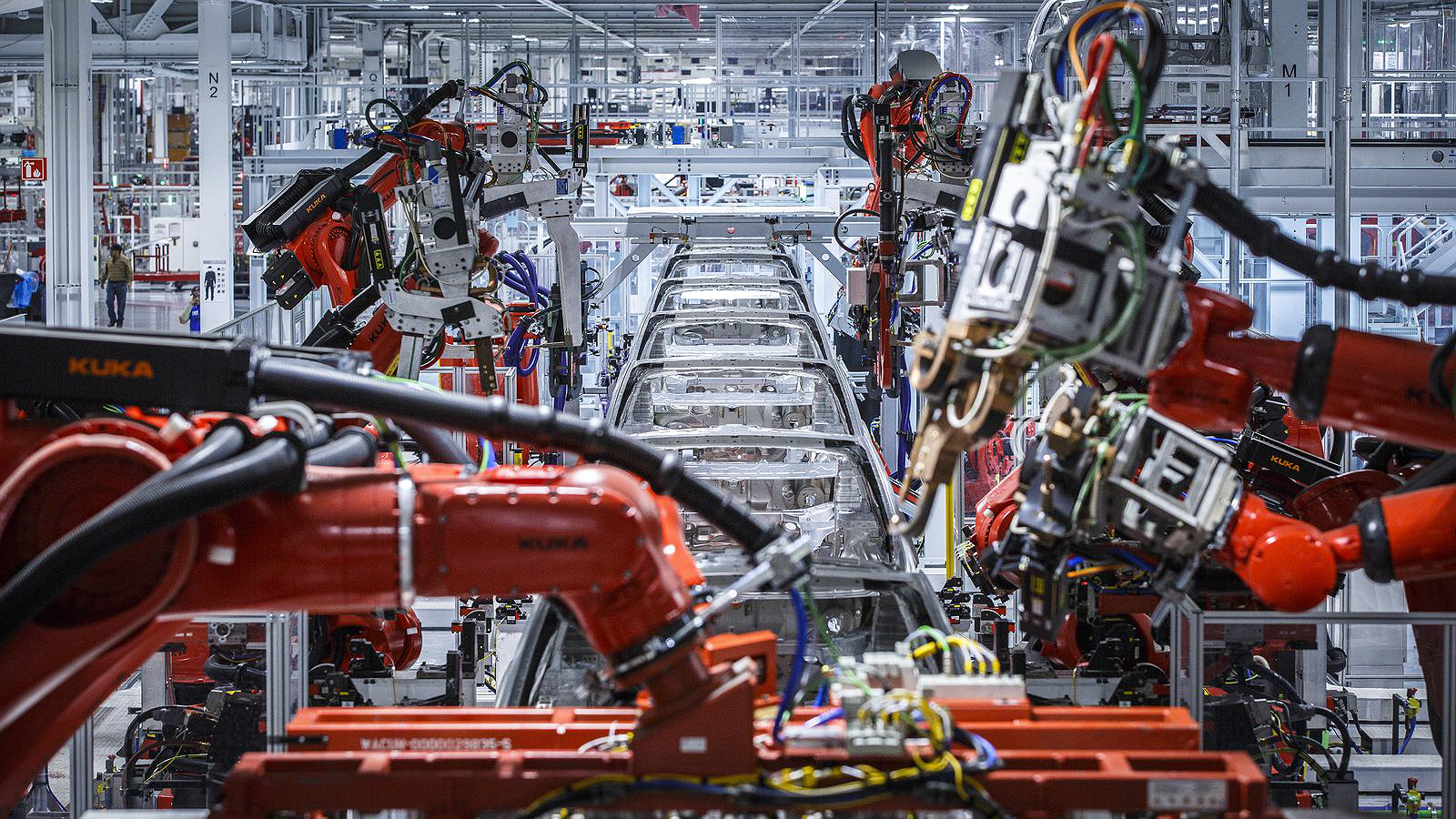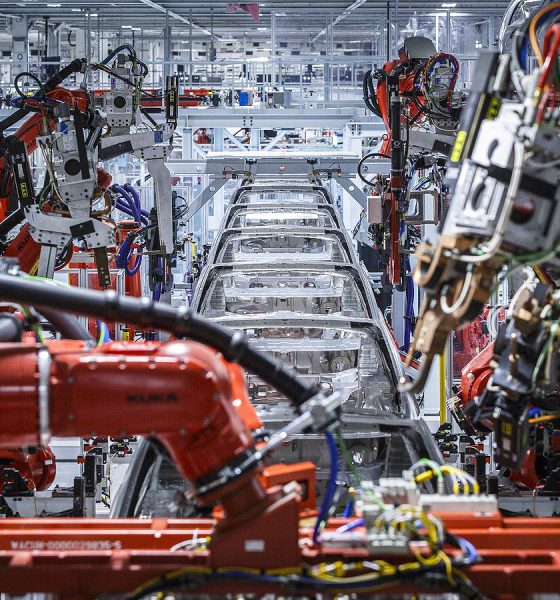

Investor's Corner
Tesla’s high-stakes ‘Blitzscaling’ strategy explained by veteran tech analyst
To say that Tesla is moving fast is an understatement. Operating under Silicon Valley principles, Tesla has exhibited insane growth over the nearly 16 years it has been in business. Today, the electric car maker is a trailblazer in the EV market, and it is poised to grow even more. Veteran tech analyst Gene Munster notes that this is made possible by a strategy that Tesla has adopted, known as “blitzscaling.”
Blitzscaling is a concept that was initially coined by Reid Hoffman of PayPal and LinkedIn fame. Companies that adopt this strategy prioritize high-speed growth over efficiency to become the first to reach a critical scale. With this strategy in place, traditional growth techniques such as careful planning, cautious investment, and a deliberate effort to solve all problems before moving forward get thrown aside.
Illustrating this point, Hoffman stated that starting a company is like jumping off a cliff and assembling a plane on the way down. Blitzscaling is jumping off a cliff and assembling the aircraft faster by strapping on and igniting a set of jet engines while still building the wings.
This strategy is incredibly dangerous, as the risks of failure are very high. Nevertheless, blitzscaling is one of the best techniques that a company could adopt if it is pursuing a very valuable prize and if the competition in its niche is intense. This fits perfectly with Tesla, whose goal is to accelerate the world’s transition to sustainable energy while surviving in the hyper-competitive auto industry.
Tesla has exhibited the signs oft blitzscaling for years, as seen in Elon Musk’s bet-the-company strategies with the Model 3 ramp. In a previous interview, Musk specifically noted that the Model 3’s “production hell” took him and Tesla to the edge. As Munster recently wrote, Tesla’s difficulties last year, including the company’s alarming financial state then, are classic characteristics of a company that is blitzscaling.
The Loup Ventures managing partner explains that blitzscaling is better suited for privately-owned companies since private investors are usually more open to the idea of investing a lot of money quickly for future growth. This could be seen in the success of companies such as Airbnb and Uber, both of which burned a lot of money to become what they are today. Tesla is in the difficult position of blitzscaling as a public company where all have access to its finances and all are able to speculate its solvency. As Tesla’s history has shown, this high-risk, high growth strategy is also a magnet for short-sellers, who can bet on the company’s failure for financial gain.
Tesla is still a young automaker, and for the most part, it is still operating like a startup. One can only hope that the Model 3 production ramp’s bet-the-company situation will not repeat itself when Tesla brings the Model Y to market. Whether or not blitzscaling is still the right strategy for Tesla at this point is up for debate, but one can only hope that the upcoming ramp for the Model Y, Solar Roof, Pickup Truck, and Tesla Semi will be a lot smoother and less painful than that of the Model 3.
Here’s Hoffman’s teaser of his book on blitzscaling. The parallels to Tesla’s strategy are quite compelling.

Investor's Corner
Tesla stock closes at all-time high on heels of Robotaxi progress

Tesla stock (NASDAQ: TSLA) closed at an all-time high on Tuesday, jumping over 3 percent during the day and finishing at $489.88.
The price beats the previous record close, which was $479.86.
Shares have had a crazy year, dipping more than 40 percent from the start of the year. The stock then started to recover once again around late April, when its price started to climb back up from the low $200 level.
This week, Tesla started to climb toward its highest levels ever, as it was revealed on Sunday that the company was testing driverless Robotaxis in Austin. The spike in value pushed the company’s valuation to $1.63 trillion.
Tesla Robotaxi goes driverless as Musk confirms Safety Monitor removal testing
It is the seventh-most valuable company on the market currently, trailing Nvidia, Apple, Alphabet (Google), Microsoft, Amazon, and Meta.
Shares closed up $14.57 today, up over 3 percent.
The stock has gone through a lot this year, as previously mentioned. Shares tumbled in Q1 due to CEO Elon Musk’s involvement with the Department of Government Efficiency (DOGE), which pulled his attention away from his companies and left a major overhang on their valuations.
However, things started to rebound halfway through the year, and as the government started to phase out the $7,500 tax credit, demand spiked as consumers tried to take advantage of it.
Q3 deliveries were the highest in company history, and Tesla responded to the loss of the tax credit with the launch of the Model 3 and Model Y Standard.
Additionally, analysts have announced high expectations this week for the company on Wall Street as Robotaxi continues to be the focus. With autonomy within Tesla’s sights, things are moving in the direction of Robotaxi being a major catalyst for growth on the Street in the coming year.
Elon Musk
Tesla needs to come through on this one Robotaxi metric, analyst says
“We think the key focus from here will be how fast Tesla can scale driverless operations (including if Tesla’s approach to software/hardware allows it to scale significantly faster than competitors, as the company has argued), and on profitability.”

Tesla needs to come through on this one Robotaxi metric, Mark Delaney of Goldman Sachs says.
Tesla is in the process of rolling out its Robotaxi platform to areas outside of Austin and the California Bay Area. It has plans to launch in five additional cities, including Houston, Dallas, Miami, Las Vegas, and Phoenix.
However, the company’s expansion is not what the focus needs to be, according to Delaney. It’s the speed of deployment.
The analyst said:
“We think the key focus from here will be how fast Tesla can scale driverless operations (including if Tesla’s approach to software/hardware allows it to scale significantly faster than competitors, as the company has argued), and on profitability.”
Profitability will come as the Robotaxi fleet expands. Making that money will be dependent on when Tesla can initiate rides in more areas, giving more customers access to the program.
There are some additional things that the company needs to make happen ahead of the major Robotaxi expansion, one of those things is launching driverless rides in Austin, the first city in which it launched the program.
This week, Tesla started testing driverless Robotaxi rides in Austin, as two different Model Y units were spotted with no occupants, a huge step in the company’s plans for the ride-sharing platform.
Tesla Robotaxi goes driverless as Musk confirms Safety Monitor removal testing
CEO Elon Musk has been hoping to remove Safety Monitors from Robotaxis in Austin for several months, first mentioning the plan to have them out by the end of 2025 in September. He confirmed on Sunday that Tesla had officially removed vehicle occupants and started testing truly unsupervised rides.
Although Safety Monitors in Austin have been sitting in the passenger’s seat, they have still had the ability to override things in case of an emergency. After all, the ultimate goal was safety and avoiding any accidents or injuries.
Goldman Sachs reiterated its ‘Neutral’ rating and its $400 price target. Delaney said, “Tesla is making progress with its autonomous technology,” and recent developments make it evident that this is true.
Investor's Corner
Tesla gets bold Robotaxi prediction from Wall Street firm
Last week, Andrew Percoco took over Tesla analysis for Morgan Stanley from Adam Jonas, who covered the stock for years. Percoco seems to be less optimistic and bullish on Tesla shares, while still being fair and balanced in his analysis.

Tesla (NASDAQ: TSLA) received a bold Robotaxi prediction from Morgan Stanley, which anticipates a dramatic increase in the size of the company’s autonomous ride-hailing suite in the coming years.
Last week, Andrew Percoco took over Tesla analysis for Morgan Stanley from Adam Jonas, who covered the stock for years. Percoco seems to be less optimistic and bullish on Tesla shares, while still being fair and balanced in his analysis.
Percoco dug into the Robotaxi fleet and its expansion in the coming years in his latest note, released on Tuesday. The firm expects Tesla to increase the Robotaxi fleet size to 1,000 vehicles in 2026. However, that’s small-scale compared to what they expect from Tesla in a decade.
Tesla expands Robotaxi app access once again, this time on a global scale
By 2035, Morgan Stanley believes there will be one million Robotaxis on the road across multiple cities, a major jump and a considerable fleet size. We assume this means the fleet of vehicles Tesla will operate internally, and not including passenger-owned vehicles that could be added through software updates.
He also listed three specific catalysts that investors should pay attention to, as these will represent the company being on track to achieve its Robotaxi dreams:
- Opening Robotaxi to the public without a Safety Monitor. Timing is unclear, but it appears that Tesla is getting closer by the day.
- Improvement in safety metrics without the Safety Monitor. Tesla’s ability to improve its safety metrics as it scales miles driven without the Safety Monitor is imperative as it looks to scale in new states and cities in 2026.
- Cybercab start of production, targeted for April 2026. Tesla’s Cybercab is a purpose-built vehicle (no steering wheel or pedals, only two seats) that is expected to be produced through its state-of-the-art unboxed manufacturing process, offering further cost reductions and thus accelerating adoption over time.
Robotaxi stands to be one of Tesla’s most significant revenue contributors, especially as the company plans to continue expanding its ride-hailing service across the world in the coming years.
Its current deployment strategy is controlled and conservative to avoid any drastic and potentially program-ruining incidents.
So far, the program, which is active in Austin and the California Bay Area, has been widely successful.








